This website was funded through the Mountain Pine Beetle Initiative, a program administered by Natural Resources Canada, Canadian Forest Service.
A healthy forest is diverse. It has trees and plants of different ages, species, heights and genetic make-up. Diversity provides good quality wildlife habitat and helps limit the size of wildfires and insect outbreaks.
In the forests of the mountain national parks, the activity of mountain pine beetle plays a role in creating forest diversity. Healthy forests are in a constant state of change in part through natural disturbances like avalanches, landslides, floods, fire and the activity of insects and diseases. Forests have evolved with these processes for thousands of years. Without them, the natural balance is lost.
While mountain pine beetle are a natural part of the southern Rocky Mountain ecosystem, recent beetle outbreaks are larger than those of the past. Decades of fire suppression have created large tracts of older pine forest that provide a highway for beetle expansion. The lack of fire, combined with a recent warming trend, means that the beetles are now occurring where they haven't been observed before: farther east, farther north and at higher elevations. This is cause for concern as the mountain national parks form the margin between the beetle outbreak in British Columbia and commercial forests in Alberta. Beetle habitat and the resulting beetle outbreak span various boundaries (provincial crown lands and parks, Indian reserves, municipal lands, commercial forest and private lands). Each jurisdiction manages the land differently (see management page).
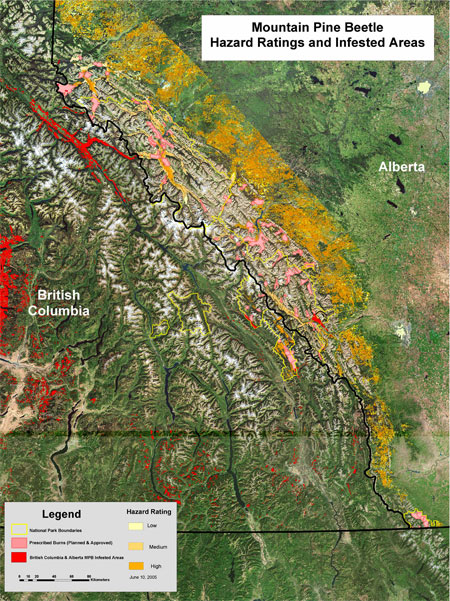 This map shows the mountain pine beetle outbreak in Alberta and British Columbia and demonstrates how forest industry and provincial and federal governments are working together to manage mountain pine beetle spread. This map shows the mountain pine beetle outbreak in Alberta and British Columbia and demonstrates how forest industry and provincial and federal governments are working together to manage mountain pine beetle spread.
© Parks Canada |
What’s on this site?
This Parks Canada mountain pine beetle web page provides you with links to several supplemental pages that can be accessed through the buttons below. For more information on healthy forests and the mountain pine beetle, visit the Canadian Forest Service (Natural Resources Canada) and the Alberta Sustainable Resource Development websites.
-
Learn why healthy mountain forests are important.
Mountain Pine Beetle – Dendroctonus ponderosae
|
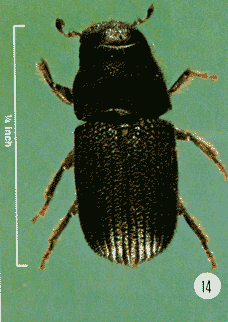
Adult mountain pine beetle, Dendroctonus ponderosae
© Canadian Forest Service
|
Mountain pine beetle is a naturally occurring insect of the Rocky Mountain Ecosystem. These small cylindrical beetles colonize and kill mature pine trees by boring through the bark and mining the layer between the bark and the wood of the tree. When conditions are favourable, mountain pine beetle populations can increase to sizeable numbers. This can result in the removal of mature pine trees over large areas.
What to look for:
- Needles or the entire crowns of trees turning red*.
- Eggs, larvae or their J-shaped galleries under the bark.
- Bubbles of tree sap or “resin” on the trunk where beetles tunnel into the bark. These are generally at mid-tree level.
- Sawdust at the base of a tree or in bark crevices.
- Woodpecker activity, such as holes in trunk and bark chips on the ground.
*It’s important to note that other insects, diseases, drought and fire can also turn trees red.
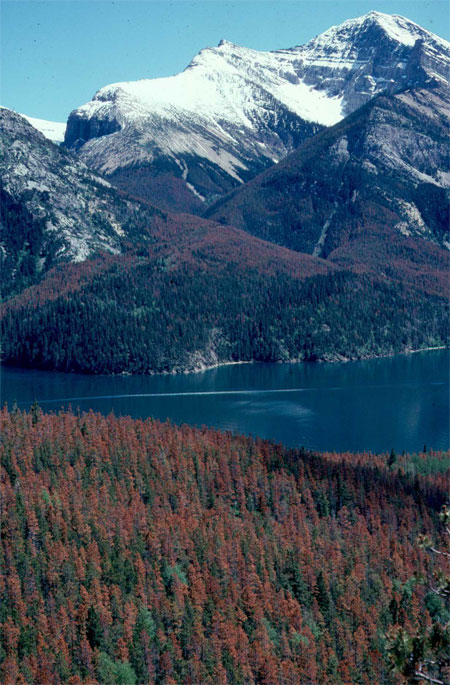 Red Trees Red Trees
© Canadian Forest Service |

 This map shows the mountain pine beetle outbreak in Alberta and British Columbia and demonstrates how forest industry and provincial and federal governments are working together to manage mountain pine beetle spread.
This map shows the mountain pine beetle outbreak in Alberta and British Columbia and demonstrates how forest industry and provincial and federal governments are working together to manage mountain pine beetle spread.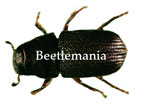











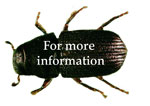
 Red Trees
Red Trees